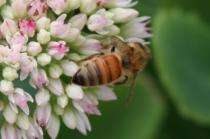How do bumblebees get predators to buzz off?

Toxic or venomous animals, like bumblebees, are often brightly coloured to tell would-be predators to keep away. However scientists at Royal Holloway, University of London and Queen Mary, University of London have found a bumblebee’s defence could extend further than its distinctive colour pattern and may indeed be linked to their characteristic shape, flight pattern or buzzing sound. The study is published today (26 May) in the Journal of Zoology.
Dr Nigel Raine, from the School of Biological Sciences at Royal Holloway, explains: “The first time a bird eats a brightly coloured bumblebee it gets a nasty surprise. Remembering the bee’s bright colours may help the bird to avoid making the same mistake again. We wanted to test the idea that bumblebee species in the same location converge on a similar appearance to enhance protection from local predators.”
The team compared the loss rates of bumblebee populations with different colour patterns in the same environment - in Sardinia, Germany and the UK. If the colour pattern is important, the researchers expected that predators would be more likely to eat bees which looked very different to those they had previously encountered in their local area. But this is not what they found.
“Predators didn’t seem to target the unusually coloured bees from the non-native populations we tested. Perhaps the bumbling way in which all bumblebees fly, or their distinctive deep buzzing are more important clues to help would-be predators avoid a nasty sting,” says Dr Raine.
Birds see the world very differently to humans, particularly their ability to see light in the ultraviolet range of the spectrum. The team compared the colour patterns of different bumblebee populations and showed that in addition to the bright bands we can see, the white tip of the bumblebee’s tail is very obvious to birds as it reflects strongly in ultraviolet light. Such signals are also important to bees which detect ultraviolet markings on flowers which are invisible to us.
Dr Raine adds, “Although birds can tell the difference between the colour patterns of the different bee populations in our experiments, they probably find it hard to tell them apart in the fraction of a second when a bee flies past. Perhaps it’s better for the bird to steer clear of all animals which look, sound, or fly like a bumblebee to avoid the danger of eating one.”
More information: Ralph J. Stelzer, Nigel E. Raine, Klaus D. Schmitt and Lars Chittka. “Effects of aposematic colouration on predation risk in bumblebees? A comparison between differently coloured populations, with consideration of the ultraviolet” Journal of Zoology, Wiley-Blackwell, May 2010, DOI:10.1111/j.1469-7998.2010.00709
Provided by Royal Holloway, University of London


















